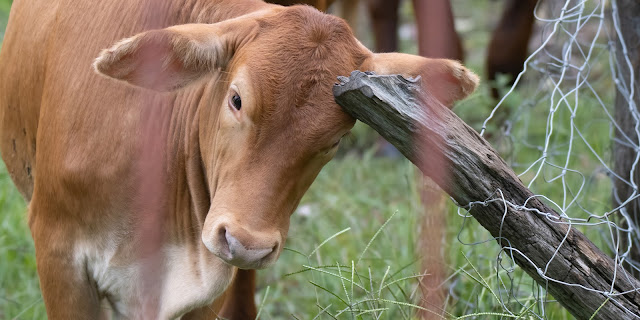Almost immediately, we saw two male Great Curassows walking down the road, a behavior Rene said he had never seen (like the Tinamous, they are normally deep in vegetation). We got a nice view, but, because I had to shoot through the windshield, I didn’t get great photos. I have fantastic shots of the same bird from Costa Rica, so that was OK.
 |
| Left, through the windshield; Right, Costa Rica |
Almost immediately after that, we saw a line of birds slowly crossing the lane that we initially thought were female Great Curassows (which are brown, not black). But, it turned out to be a Plain Chachalaca parade.
 |
| This trip gave me several great views of this sometimes-reclusive bird |
We saw lots of the same birds we had been seeing all week (I will spare you reading a list this time) but we were concentrating on one that had been evading us all week: the Golden-olive Woodpecker (Bronze-winged).
 |
| Speaker in the road |
On multiple occasions, Rene had picked up their song and we had seen what may have been one deep in the tree.
I saw the birds that he said were Golden-olive Woodpeckers, but not well enough to even claim them on eBird. I wanted to actually see the bird.
We stopped twice for extended periods of calling, listening and seeing distant activity that may or may not have been the bird.
 |
| Using a cell phone and a speaker to call birds |
Finally, on the third stop, we spotted one, a female, way up in the dense trees. We never got an extraordinary view, but we saw it well enough for me to claim it.
And, I did get photos.
 |
| Right above us for a minute |
This was probably our most difficult achieved target and we did it on the last day!
 |
| She moved farther away and stayed for awhile |
As we moved into an area with cattle …
… and sugar cane …
 |
| Susan birding in the cane field |
… we started looking for Northern Bobwhites. This is a bird that I have long wanted to photograph. I grew up in an area rife with them, but since I became a birder have seen them only once, at San Angelo State Park in Texas where I went specifically to catch them and still didn’t get a shot.
We heard a few, played some calls and one flew right at us. We thought it was going to pass us by, but then it returned and trotted up and down the road for a bit.
 |
| Could I get closer? |
 |
It’s call is a distinctive (and loud) “Bob White, Bob White, Bob White” |
In the same area we saw (these pictures just show one of the many we often saw):
 |
| Some Eastern Meadowlarks (we saw a Western in the Chihuahua Desert) |
 |
| A couple of Montezuma Oropendolas |
 |
| Two more Roadside Hawks |
 |
| A White-winged Dove |
 |
| And a female Yellow-faced Grassquit |
On our way toward the end of our trip, we stopped at a dead tree to photograph a Black-crowned Tityra.
I couldn’t see it until I got out of the car and, then, Heather pointed out the location on a branch about two-thirds of the way up the tree.
 |
| It was a male, out in the open, posing for us |
As Susan was observing the bird through her binoculars, she asked Rene about the rufous malars. Heather and I were confused because we saw no brown or rust, just black and white. Susan and Rene were puzzled that we couldn’t see the brown. Then, we realized that there was a pair – a black and white male and a black, brown and white female – sitting on separate branches, the male above the female.
 |
| I hadn’t seen a female before |
 |
| So, that was fun! |
The drive was lovely and the birding was good, but, our tour was almost over. Where did the time go?
 |
| Azteca at the end of the road |
A Quick Final Stop
Then, we made one more stop, touring the El Cielo Interpretive Center. It is a large modern building with ramps that are a little scary because they are wet from condensation, rain or the center’s wall fountain.
 |
| El Cielo Interpretive Center |
 |
| A captive Red-lored Parrot |
Here's a couple arguing:
They also have a few caged animals, including local species like a Black Bear, a Bobcat, a variety of snakes and some Jaguarundis plus some inexplicable exotics including a whole family of Ring-tail Lemurs.
We met one of the founders of the center, who gave us a rather extended tour. I was confused because I wasn’t sure if Rene had asked him to guide us or if Rene was even a friend. At first, I felt like he was rather pushy and wanted him to leave us alone.
 |
| A wild magnolia outside the Interpretive Center |
Later, he joined us for lunch at Comidas Sierra Bonita. This time, I had gorditas, also yummy. Mexican food definitely got better during this part of the trip.
But, we were out of time. We made the long drive back to Monterrey, arriving in time for dinner which, at Susan’s and Heather’s request, we had at a Carl’s Junior. I wasn’t mad about it.
We stayed at an Ibis Hotel close to the airport and left the next morning for an uneventful trip home.
Although many of the 140 birds I saw were repeats from South Texas and/or Costa Rica, I did gather 34 lifers, most of which I was able to photograph.
 |
| A productive trip |
We’ll see.
Trip Date: August 12-18







No comments:
Post a Comment